#Natovenator polydontus
Text
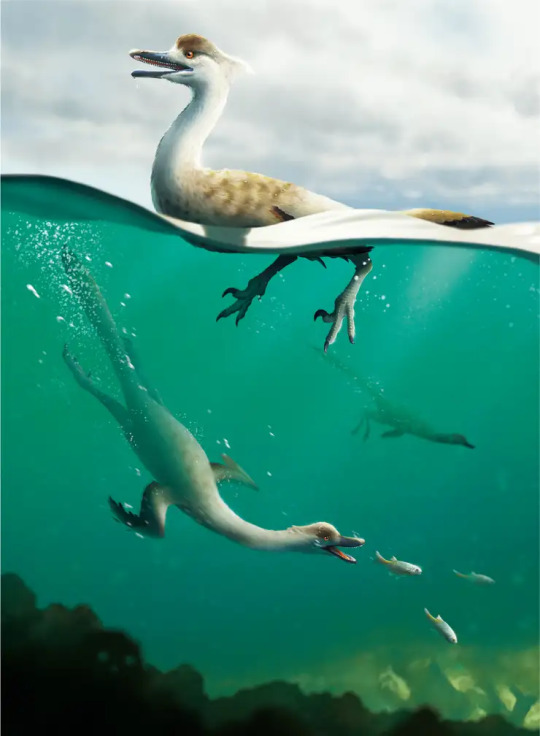
Excerpt:
Paleontologists discovered a 71-million-year-old carnivorous dinosaur in Southern Mongolia that they believe had a body built for swimming and diving for prey. Though it looks a lot like a modern bird, it’s actually a non-avian dinosaur, meaning it’s likely an example of convergent evolution, a phenomenon in which unrelated creatures evolve similar traits.
The dinosaur is called Natovenator polydontus, or “swimming hunter with many teeth.” Recent analysis of its fossilized remains indicate the animal was bipedal and built for diving. A full description of the newly discovered animal is published in Communications Biology.
4 notes
·
View notes
Text
Natovenator polydontus enjoys a sunset swim by the shores of a shallow sea.
Natovenator was a small, semi-aquatic Cretaceous dromaeosaurid discovered in November 2022, whose features imply a potentially similar swimming/diving lifestyle to many modern waterbirds.
Forgot to post this one earlier, so here it is now!
878 notes
·
View notes
Text
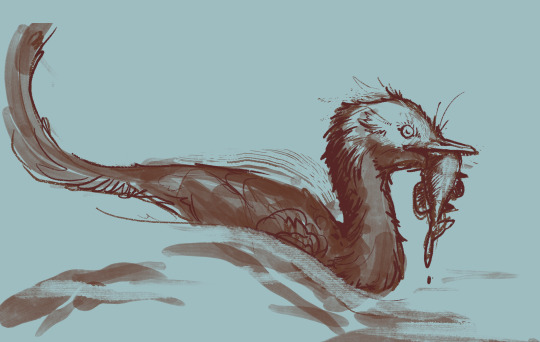
Natovenator polydontus
171 notes
·
View notes
Text

Halszkaraptorines were a group of small dromaeosaurids known only from the Late Cretaceous of Mongolia. They were odd little raptors with flattened snouts, long necks, and flipper-like arms – features that suggest they were specialized for swimming, making them the second known lineage of semi-aquatic non-avian dinosaurs after the spinosaurids.
This "duck-raptor" interpretation has been a little controversial since it was first proposed in 2017, but we've just gotten some more evidence for it in the form of an entirely new halszkaraptorine.
Natovenator polydontus lived in what is now the Gobi Desert in southern Mongolia, around 72 million years ago. The size of a small duck, about 45cm long (18"), it had jaws full of many needle-like teeth, a long flexible goose-like neck, and a streamlined body with a wide flattened ribcage convergently shaped like those of modern diving birds.
Although it had long strong legs, these don't show much in the way of aquatic specializations and would have been used more for walking and running on land. Instead it may have used its flipper-like arms to propel itself through the water, like modern penguins or auks.
It probably had a lifestyle similar to modern mergansers, swimming and diving in lakes and rivers, and preying on fish, amphibians, and aquatic invertebrates.
———
Nix Illustration | Tumblr | Twitter | Patreon
#science illustration#paleontology#paleoart#palaeoblr#natovenator#halszkaraptorinae#dromaeosaur#raptor#paraves#maniraptora#theropod#dinosaur#art#duckraptor#actual water dinosaurs
602 notes
·
View notes
Text
Daurlong vs Natovenator


Factfiles:
Daurlong wangi

Artwork by @i-draws-dinosaurs, written by @i-draws-dinosaurs
Meaning: Wang’s Daur dragon (named for the Daur people of Northeast China)
Time: 121 million years ago (Aptian stage of the Early Cretaceous)
Location: Longjiang Formation, Inner Mongolia, China
Daurlong was described in 2022, from a stunningly beautiful fossil that includes the entire body, crushed flat by pressure, and a whole lot of soft tissues like feathers along the back of the neck and even the shape of the intestines! Any part of the digestive system is extremely rare to find in fossils, so Daurlong provides an important glimpse into how the digestive systems of birdlike dinosaurs compare to living dinosaurs today!
Turns out, despite being closely related to the ancestors of modern birds Daurlong’s guts were pretty similar to other, much more distant theropods like Scipionyx instead. That helps fill in a pretty big gap in our knowledge of how the bird digestive system evolved, making this a very scientifically valuable fossil!
That, and it’s just adorable. Look at that lil smiley face!
Natovenator polydontus

Artwork by Yusik Choi, written by @zygodactylus
Name Meaning: Many toothed swimming hunter
Time: 71 million years ago (Maastrichtian stage of the Late Cretaceous)
Location: Hermiin Tsav, Barun Goyot Formation, Ömnögovi, Mongolia
Back in my day, we famously said dinosaurs weren’t aquatic or volant, apart from birds that fit the bill. Fortunately, my childhood is over, and we have both flighted and aquatic nonavians - Natovenator being the next iteration in this strange new reality. Like its cousin Halszkaraptor, Natovenator was a semiaquatic raptor, adapted for moving through the water, potentially with wing flippers to do so. It had a long snout with many teeth adapted for grabbing aquatic life, and it had a long neck similar to modern day diving birds to help it catch prey. It had a streamlined body, allowing it to dive and move through the water efficiently. The long snout was not spatulate, but did curve upward a bit, giving it a vaguely-duck like appearance. The small pointed teeth would have been excellent for grabbing on to struggling fish. Living in the Barun Goyot, a desert ecosystem, Natovenator probably congregated around steady sources of water, such as periodic lakes and oases like those found in modern deserts today. Many mammals are known from the ecosystem, but the real standout stars are dinosaurs: Natoveantor shared its habitat with Ceratonykus, Saichania, Tarchia, Zaraapelta, Gobipipus, Gobipteryx, Hollanda, Bagaceratops, other dromaeosaurs, Conchoraptor, Heyuannia, and unnamed sauropods known only from eggs. Appearing after the Djadokhta and preceding the Nemegt, this environment was a transitional one from the Campanian of Asia to the Maastrichtian, as the environment became more diverse and filled with truly insane numbers of dinosaurs as the period reached its end.
DMM Round One Masterpost
#dmm#dinosaur march madness#dinosaurs#paleontology#dmm round one#dmm rising stars#palaeoblr#bracket#march madness#polls#daurlong#natovenator
160 notes
·
View notes
Text
Natovenator polydontus Lee et al., 2022 (new genus and species)
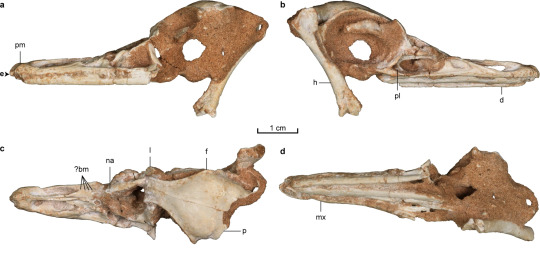
(Skull of Natovenator polydontus, from Lee et al., 2022)
Meaning of name: Natovenator = swimming hunter [in Latin]; polydontus = many teeth [in Greek]
Age: Late Cretaceous (Campanian–Maastrichtian?)
Where found: Barun Goyot Formation, Ömnögov, Mongolia
How much is known: Partial skeleton of one individual, including a nearly complete skull and parts of the ribcage and limbs.
Notes: Natovenator was a halszkaraptorine dromaeosaurid. Based on features such as numerous teeth, a long neck, and flattened forelimb bones, at least some members of this group have been considered semi-aquatic foragers, though this hypothesis has also been questioned. Natovenator preserves enough of the ribcage (which is mostly unknown in other halszkaraptorines) to indicate that it had a vertically compressed torso with backswept ribs. Its describers interpret these as potential swimming adaptations that streamlined the body, and thus argue in favor of a semi-aquatic lifestyle for these dinosaurs.
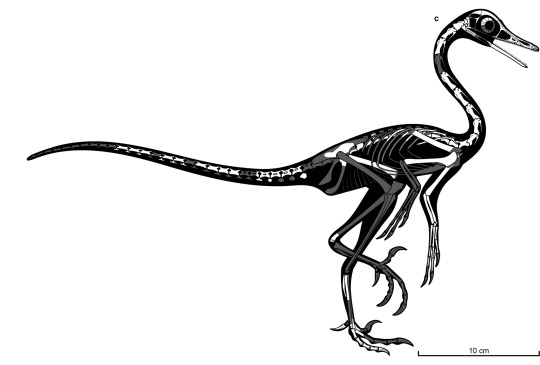
(Schematic skeletal of Natovenator polydontus with preserved bones in white, from Lee et al., 2022)
Reference: Lee, S., Y.-N. Lee, P.J. Currie, R. Sissons, J.-Y. Park, S.-H. Kim, R. Barsbold, and K. Tsogtbaatar. 2022. A non-avian dinosaur with a streamlined body exhibits potential adaptations for swimming. Communications Biology 5: 1185. doi: 10.1038/s42003-022-04119-9
88 notes
·
View notes
Photo

An illustration of the donosaur Natovenator Polydontus. Its name means “swimming hunter with many teeth.”
Credit...Yusik Choi
57 notes
·
View notes
Text
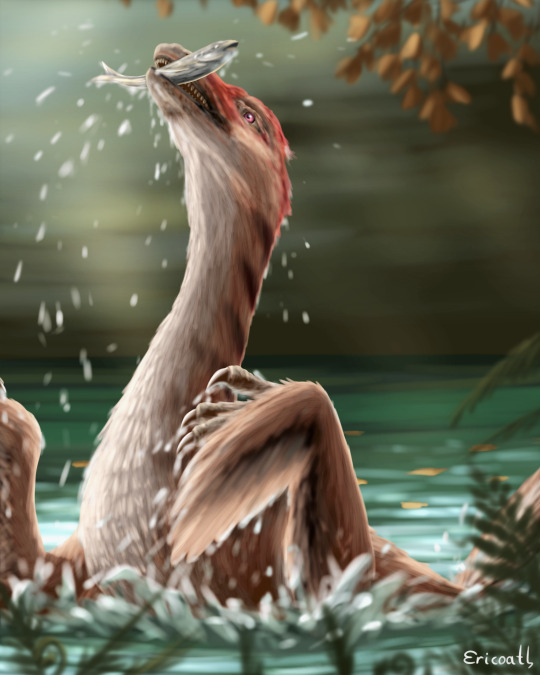
Natovenator polydontus, swimming dinosaur.
61 notes
·
View notes
Photo
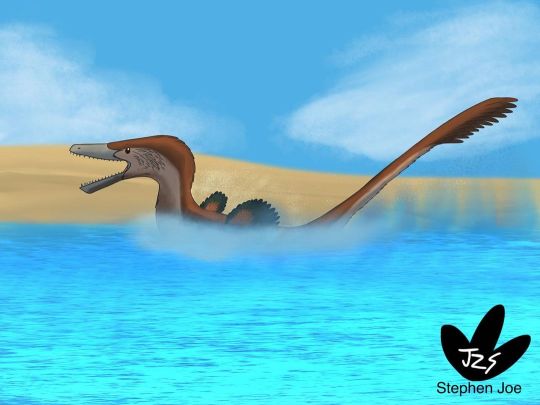
A Halszkaraptorinae Natovenator polydontus is splashed with water while enjoy swimming. This is insane moment between yesterday and even today. At first, I was gonna redrawn Spinosaurus after I read paleo news about he’s no longer just an aquatic dinosaur (along add a cartoon gag for having fun), but then suddenly when I do heard there’s another theropoda dinosaur that is not just aquatic, but also another Halszkaraptorinae as well. Which is why they named the new specie of Dromaeosaurid Natovenator polydontus, meaning “Swimming hunter with many teeth.” On the side note, I just nailed the both foreground and background with free brushes from sketchbook pro/app thanks to iOS updates with V6, along with cheaply payment of Premium Bundle, so I could happily get a lots (or maybe few) of brushes for free, and possibly going to experience with sketchbook app where I could never use it before. #natovenator #natovenatorpolydontus #halszkaraptorinae #dromaeosauridae #paraves #maniraptora #theropoda #dinosauria #dinosaur #paleoart #sketchbookapp #artistsoninstagram #myart https://www.instagram.com/p/Clpf4kgLjDr/?igshid=NGJjMDIxMWI=
#natovenator#natovenatorpolydontus#halszkaraptorinae#dromaeosauridae#paraves#maniraptora#theropoda#dinosauria#dinosaur#paleoart#sketchbookapp#artistsoninstagram#myart
11 notes
·
View notes
Photo
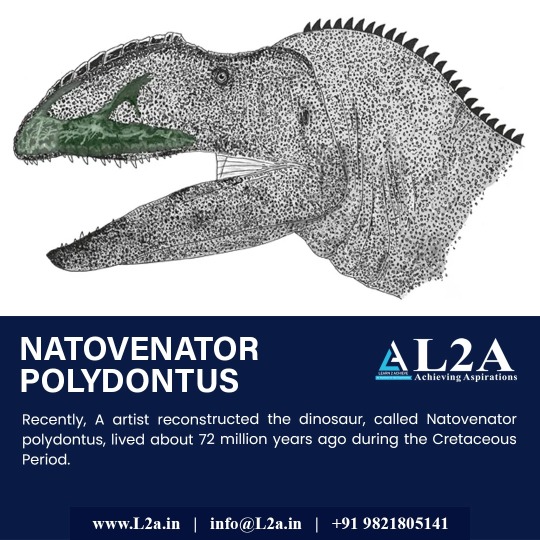
Current Affairs | 05-12-2022 | L2A
1) Natovenator is a genus of halszkaraptorine dromaeosaurid dinosaur from the Late Cretaceous Barun Goyot Formation of Mongolia Region in Asia.
2) The genus is known from a one species, N. polydontus.
3) Natovenator is crucial to the understanding of halszkaraptorines due to it providing more support for the semi-aquatic lifestyle(can live in both land and water) that has been proposed for this clade.
4) This discovery is important as the semi-aquatic lifestyles of halszkaraptorines was contested earlier in 2022 year.
5) Natovenator was a very small theropod, comparable in appearance to extant waterfowl, like other groups of the Halszkaraptorinae.
6) Natovenator is different from other halszkaraptorines due to features such as a wide groove delimited by a pair of ridges on the anterodorsal surface of the premaxilla part.
7) A premaxilla with an elongated internarial process that elongated nasal and extends posterior to the external naris, with the set of 13 premaxillary teeth with large and incisiviform crowns.
The absence of pleurocoels in cervical vertebrae in back, and an hourglass-shaped metacarpal II, among other features.
9) The parapophyses in its vertebrae are similar to the extinct species of Hesperornithiformes, which were toothed diving birds.
#currentaffairs#currentaffairs2022#currentaffairsquiz#l2a#learn2achieve#IAS#UPSC#upscpreparation#upscmotivation#upsccoaching#explore#explorepage
0 notes
Text
Un dinosauro del cretaceo simile a un uccello aveva gli adattamenti per nuotare e tuffarsi
Un dinosauro del cretaceo simile a un uccello aveva gli adattamenti per nuotare e tuffarsi
Natovenator polydontus.
Un nuovo genere e una nuova specie di dinosauro teropode con un corpo affusolato come quello degli uccelli tuffatori è stato identificato da uno scheletro ben conservato trovato in Mongolia.
La specie di dinosauro appena identificata visse in Mongolia durante il tardo Cretaceo, circa 71 milioni di anni fa.
Chiamata Natovenator polydontus, l’antica creatura aveva un…

View On WordPress
0 notes
Text
Predatory penguin-like dinosaur lived in Mongolia 70 million years ago
Predatory penguin-like dinosaur lived in Mongolia 70 million years ago
Is it a bird? No, it’s a swimming dinosaur! Predatory penguin-like creature that was more suited to water than land lived in Mongolia 70 million years ago
Natovenator polydontus lived in what is now Mongolia some 70 million years agoThe predatory dinosaur once swam through the water like a penguin, study findsIt was as big as a chicken and had flipper-like arms similar to wings of a…

View On WordPress
0 notes
